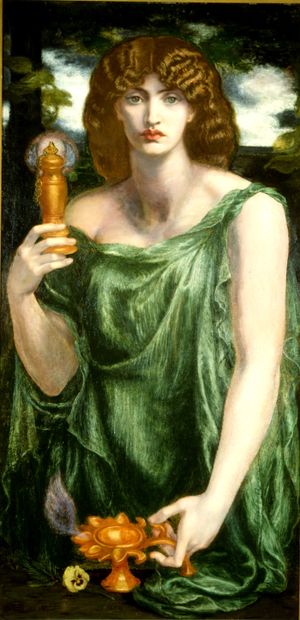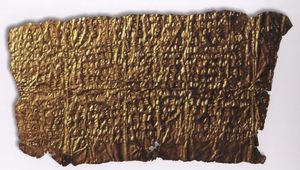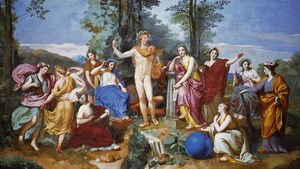منىموسينى
| منىموسينى Mnemosyne | |
|---|---|
إلهة الذاكرة والتذكر من الجبابرة | |
| عضو في التيتان | |
 منىموسينى (وتُعرف أيضاً بإسم مصباح الذاكرة أو Ricordanza) بريشة دانتى گابرييل روستي (ح. 1876 إلى 1881) | |
| المسكن | جبل اوليمپوس |
| معلومات شخصية | |
| الأبوان | Uranus and Gaia |
| الأشقاء | |
| القرينات | زيوس |
| الأنجال | |
| الآلهة المكافئة | |
| المكافئ الروماني | مونـِتا |
منىموسينى (Mnemosyne ؛ /nɪˈmɒzɪniː,_nɪˈmɒsɪniː/؛ باليونانية: Μνημοσύνη؛ تـُنطق [mnɛːmosýːnɛː]) هي إلهة الذاكرة في الأساطير اليونانية. "Mnemosyne" مشتقة من نفس المصدر مثل كلمة mnemonic، الذي هو الكلمة اليونانية mnēmē، التي تعني "التذكر، الذاكرة".[1][2]
منىموسينى هي أم ربات الإلهام التسع.
العائلة
بصفتها من التيتان، منىموسينى كانت ابنة أورانوس و گايا.[3][4][5] كانت منىموسينى أماً لربات الإلهام التسع، من ابن عمها زيوس:
- كاليوپى (الشعر الملحمي)
- كليو (التاريخ)
- Euterpe (الموسيقى)
- إراتو (الشعر الغنائي)
- ملپومنى (التراجيديا)
- پوليهمنيا (الترانيم)
- Terpsichore (الرقص)
- ثاليا (الكوميديا)
- أورانيا (الفلك)
الأساطير
In Hesiod's Theogony, kings and poets receive their powers of authoritative speech from their possession of Mnemosyne and their special relationship with the Muses.
Zeus, in a form of a mortal shepherd, and Mnemosyne slept together for nine consecutive nights, thus conceiving the nine Muses. Mnemosyne also presided over a pool[6] in Hades, counterpart to the river Lethe, according to a series of 4th-century BC Greek funerary inscriptions in dactylic hexameter. Dead souls drank from Lethe so they would not remember their past lives when reincarnated. In Orphism, the initiated were taught to instead drink from the Mnemosyne, the river of memory, which would stop the transmigration of the soul.[7]
ظهورها في الأدب الشفهي

Although she was categorized as one of the Titans in the Theogony, Mnemosyne did not quite fit that distinction.[8] Titans were hardly worshiped in Ancient Greece, and were thought of as so archaic as to belong to the ancient past.[8] They resembled historical figures more than anything else. Mnemosyne, on the other hand, traditionally appeared in the first few lines of many oral epic poems [9]—she appears in both the Iliad and the Odyssey, among others—as the speaker called upon her aid in accurately remembering and performing the poem they were about to recite. Mnemosyne is thought to have been given the distinction of "Titan" because memory was so important and basic to the oral culture of the Greeks that they deemed her one of the essential building blocks of civilization in their creation myth.[9]
Later, once written literature overtook the oral recitation of epics, Plato made reference in his Euthydemus to the older tradition of invoking Mnemosyne. The character Socrates prepares to recount a story and says "ὥστ᾽ ἔγωγε, καθάπερ οἱ (275d) ποιηταί, δέομαι ἀρχόμενος τῆς διηγήσεως Μούσας τε καὶ Μνημοσύνην ἐπικαλεῖσθαι." which translates to "Consequently, like the poets, I must needs begin my narrative with an invocation of the Muses and Memory" (emphasis added).[10] Aristophanes also harked back to the tradition in his play Lysistrata when a drunken Spartan ambassador invokes her name while prancing around pretending to be a bard from times of yore.[11]
العبادة

While not one of the most popular divinities, Mnemosyne was the subject of some minor worship in Ancient Greece. Statues of her are mentioned in the sanctuaries of other gods, and she was often depicted alongside her daughters the Muses. She was also worshipped in Lebadeia in Boeotia, at Mount Helicon in Boeotia, and in the cult of أسكلپيوس.
There was a statue of Mnemosyne in the shrine of Dionysos at Athens, alongside the statues of the Muses, Zeus and Apollo,[12] as well as a statue with her daughters the Muses in the Temple of Athena Alea.[13] Pausanias described the worship of Mnemosyne in Lebadeia in Boeotia, where she played an important part in the oracular sanctuary of Trophonios:
[Part of the rituals at the oracle of Trophonios (Trophonius) at Lebadeia, Boiotia (Boeotia):] He [the supplicant] is taken by the priests, not at once to the oracle, but to fountains of water very near to each other. Here he must drink water called the water of Lethe (Forgetfulness), that he may forget all that he has been thinking of hitherto, and afterwards he drinks of another water, the water of Mnemosyne (Memory), which causes him to remember what he sees after his descent ... After his ascent from [the oracle of] Trophonios the inquirer is again taken in hand by the priests, who set him upon a chair called the chair of Mnemosyne (Memory), which stands not far from the shrine, and they ask of him, when seated there, all he has seen or learned. After gaining this information they then entrust him to his relatives. These lift him, paralysed with terror and unconscious both of himself and of his surroundings, and carry him to the building where he lodged before with Tykhe (Tyche, Fortune) and the Daimon Agathon (Good Spirit). Afterwards, however, he will recover all his faculties, and the power to laugh will return to him.
— Pausanias[14]
Mnemosyne was also sometime regarded as being not the mother of the Muses but as one of them, and as such she was worshiped in the sanctuary of the Muses at Mount Helicon in Boeotia:
The first to sacrifice on Helikon (Helicon) to the Mousai (Muses) and to call the mountain sacred to the Mousai were, they say, Ephialtes and Otos (Otus), who also founded Askra ... The sons of Aloeus held that the Mousai were three in number, and gave them the names Melete (Practice), Mneme (Memory), and Aoide (Aeode, Song). But they say that afterwards Pieros (Pierus), a Makedonian (Macedonian) ... came to Thespiae [in Boiotia] and established nine Mousai, changing their names to the present ones ... Mimnermos [epic poet C7th B.C.] ... says in the preface that the elder Mousai (Muses) are the daughters of Ouranos (Uranus), and that there are other and younger Mousai, children of Zeus.
— Pausanias[15]
عبادة أسكلپيوس
Mnemosyne was one of the deities worshiped in the cult of أسكلپيوس that formed in Ancient Greece around the 5th century BC.[16] أسكلپيوس، البطل والإله اليوناني للطب, was said to have been able to cure maladies, and the cult incorporated a multitude of other Greek heroes and gods in its process of healing.[16] The exact order of the offerings and prayers varied by location,[17] and the supplicant often made an offering to Mnemosyne.[16] After making an offering to أسكلپيوس himself, in some locations, one last prayer was said to Mnemosyne as the supplicant moved to the holiest portion of the asclepeion to incubate.[16] The hope was that a prayer to Mnemosyne would help the supplicant remember any visions had while sleeping there.[17]
شجرة العائلة
| شجرة عائلة منىموسينى [18] |
|---|
انظر أيضاً
الهامش
- ^ Liddell, Henry George; Scott, Robert (1940). Jones, Sir Henry Stuart; McKenzie, Roderick (eds.). "μνήμη". A Greek-English Lexicon. Oxford: Clarendon Press. Retrieved 2018-01-10.
- ^ Memory and the name Memnon, as in "Memnon of Rhodes" are etymologically related. Mnemosyne is sometimes confused with Mneme or compared with Memoria.
- ^ هسيود. Theogony, 135
- ^ كلمنت السكندري. Recognitions, 31
- ^ ديودورس الصقلي. Bibliotheca historica, 5.66.3
- ^ Richard Janko, "Forgetfulness in the Golden Tablets of Memory", Classical Quarterly 34 (1984) 89–100; see article "Totenpass" for the reconstructed devotional which instructs the initiated soul through the landscape of Hades, including the pool of Memory.
- ^ "Lethe | Greek mythology". Encyclopedia Britannica (in الإنجليزية). Retrieved 2017-03-30.
- ^ أ ب Rose, H.J. (1991). A Handbook of Greek Mythology : including its extension to Rome (6th ed.). London: Taylor and Francis, Inc. ISBN 9780415046015.
- ^ أ ب Notopoulos, James A. (1938). "Mnemosyne in Oral Literature". Transactions and Proceedings of the American Philological Association. 69: 466. doi:10.2307/283194.
- ^ Plato; Burnet, James (1903). Platonis Opera. Oxford University Press.
- ^ "Aristophanes, Lysistrata, line 1247". www.perseus.tufts.edu.
- ^ Pausanias, Description of Greece 1. 2. 5 (trans. Jones) (Greek travelogue C2nd A.D.)
- ^ Pausanias, Description of Greece 8. 46. 3
- ^ Pausanias, Description of Greece 9. 39. 3
- ^ Pausanias, Description of Greece 9. 29. 1
- ^ أ ب ت ث Ahearne-Kroll, Stephen P. (April 2014). "Mnemosyne at the Asklepieia". Classical Philology. 109 (2): 99–118. doi:10.1086/675272.
- ^ أ ب von Ehrenheim, Hedvig (2011). Greek incubation rituals in Classical and Hellenistic times. Stockholm: Department of Archaeology and Classical Studies, Stockholm University. ISBN 978-91-7447-335-3.
- ^ هسيود، Theogony 132–138, 337–411, 453–520, 901–906, 915–920; Caldwell, pp. 8–11, tables 11–14.
- ^ Although usually the daughter of Hyperion and Theia، كما في هسيود، Theogony 371–374، في Homeric Hymn to Hermes (4), 99–100, Selene is instead made the daughter of Pallas the son of Megamedes.
- ^ According to Hesiod, Theogony 507–511, Clymene, one of the Oceanids, the daughters of Oceanus and Tethys, at Hesiod, Theogony 351, was the mother by Iapetus of Atlas, Menoetius, Prometheus, and Epimetheus, while according to Apollodorus, 1.2.3, another Oceanid, Asia was their mother by Iapetus.
- ^ According to Plato, Critias, 113d–114a, Atlas was the son of Poseidon and the mortal Cleito.
- ^ In Aeschylus, Prometheus Bound 18, 211, 873 (Sommerstein, pp. 444–445 n. 2, 446–447 n. 24, 538–539 n. 113) Prometheus is made to be the son of Themis.
المراجع
- Hesiod, The Homeric Hymns and Homerica with an English Translation by Hugh G. Evelyn-White, Cambridge, MA.,Harvard University Press; London, William Heinemann Ltd. 1914. Online version at the Perseus Digital Library.
- Anonymous, The Homeric Hymns and Homerica with an English Translation by Hugh G. Evelyn-White. Homeric Hymns. Cambridge, MA.,Harvard University Press; London, William Heinemann Ltd. 1914. Online version at the Perseus Digital Library.
- Aeschylus, Persians. Seven against Thebes. Suppliants. Prometheus Bound. Edited and translated by Alan H. Sommerstein. Loeb Classical Library No. 145. Cambridge, Massachusetts: Harvard University Press, 2009. ISBN 978-0-674-99627-4. Online version at Harvard University Press.
- Diodorus Siculus, Diodorus Siculus: The Library of History. Translated by Charles Henry Oldfather. Twelve volumes. Loeb Classical Library. Cambridge, Massachusetts: Harvard University Press; London: William Heinemann, Ltd. 1989.Online version at the Lacus Curtius: Into the Roman World.
- Ovid, Metamorphoses translated by Brookes More (1859-1942). Boston, Cornhill Publishing Co. 1922. Online version at the Topos Text Project.
- Apollodorus, Apollodorus, The Library, with an English Translation by Sir James George Frazer, F.B.A., F.R.S. in 2 Volumes. Cambridge, Massachusetts, Harvard University Press; London, William Heinemann Ltd. 1921. Online version at the Perseus Digital Library.
- Hyginus, Fabulae from The Myths of Hyginus translated and edited by Mary Grant. University of Kansas Publications in Humanistic Studies. Online version at the Topos Text Project.
- Pausanias, Description of Greece with an English Translation by W.H.S. Jones, Litt.D., and H.A. Ormerod, M.A., in 4 Volumes. Cambridge, MA, Harvard University Press; London, William Heinemann Ltd. 1918. Online version at the Perseus Digital Library
- Antoninus Liberalis, The Metamorphoses of Antoninus Liberalis translated by Francis Celoria (Routledge 1992). Online version at the Topos Text Project.
- Clement of Alexandria, Recognitions from Ante-Nicene Library Volume 8, translated by Smith, Rev. Thomas. T. & T. Clark, Edinburgh. 1867. Online version at theio.com
- Caldwell, Richard, Hesiod's Theogony, Focus Publishing/R. Pullins Company (June 1, 1987). ISBN 978-0-941051-00-2.
للاستزادة
- Zuntz, Günther (1971). Persephone: Three Essays on Religion and Thought in Magna Graecia. Cambridge: Clarendon Press. ISBN 9780198142867. OCLC 303807.
وصلات خارجية
 Media related to Mnemosyne at Wikimedia Commons
Media related to Mnemosyne at Wikimedia Commons
